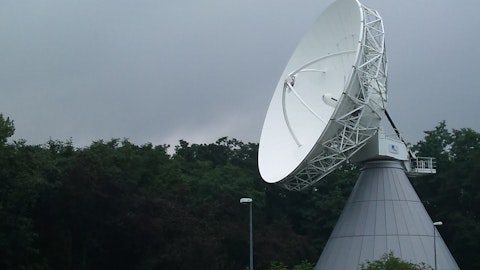Thomas McClelland: No, we do not. In fact, that’s one of the things. This is — there’s very little new development on this. It’s basically building hardware, it’s production job. And it — there’s every reason to believe that we should be very, very successful on this one.
Unidentified Analyst: Okay. One final one for me. Investors look at FEI pretty much as a satellite program company. But the Zyfer and the non-satellite business seems to be going quite well. Are there big orders associated with that business? Or is it more continuing orders? Or is it smaller orders, but the numbers are quite impressive, how that’s going?
Thomas McClelland: Yeah. They actually have been very successful over the past couple of quarters in getting new work, completely new stuff. And of course, there are also continuing orders on their existing products. So they went through a rough patch about a year ago. Things were moved around the country but they’ve surprised us all actually in their ability to turn things around. And things are really just looking really good at Zyfer at this point in time.
Unidentified Analyst: And is the — are the margins at Zyfer similar to the satellite? Or is there any difference in the margin structure of those two operations?
Thomas McClelland: Yeah. I think they’re — the numbers aren’t that different when you look at them, but I think the details of how you get there are definitely not quite the same.
Unidentified Analyst: All right. Well, Thank you very much. I wish you best of luck in the coming quarters.
Thomas McClelland: Thank you.
Operator: Thank you. The next question is coming from George Marema from Pareto Ventures. George, your line is live.
George Marema: Hi, thanks for taking my call. I had a question about your SG&A, R&D expenses. As revenues increase and if you get near your gross margin — well, let me ask it a different way. If you get towards your gross margin goals, what would net margins approximately look like?
Thomas McClelland: Steve, I’ll let you take that one.
Steve Bernstein: So SG&A on a dollar value number is going to run fairly consistent. I mean, again, if we grow substantially, yes, there’ll be some more costs in there. But percent-wise, as you see, it went down for getting the percentage to dollars even as a formula of income is down. So we expect it to stay at that current level where it is now unless things substantially grow.
George Marema: Okay. And you don’t expect the net margin to expand as a percentage of sales?
Steve Bernstein: Gross margin or SG&A?
George Marema: No, net margin. Well, let’s say your gross margin does 50%, what would you anticipate on a net margin — operating margin, right?
Steve Bernstein: I would have to look at it, but it will go up. And again, I think, like I said, the actual cost structure will be relatively the same, all in all.
George Marema: So the SG&A right now is about [$2.5 million] (ph) a quarter. You don’t expect that to increase too much?
Steve Bernstein: No, I do not.
George Marema: Okay. All right. And also after you’ve won a couple of these big jobs here recently, what kind of the opportunity outlook over the next couple of years look like, the opportunity set? Pipeline?
Thomas McClelland: The opportunities are — look really great. We — you might imagine that we got been working on these three jobs for some time, and we finally got them and that’s it. But the reality is that we were just actually overwhelmed with opportunities at this point in time. Space is booming. And I don’t see that turning around anytime soon.
George Marema: Okay. So a lot more. You mentioned you may have some small wins here in the coming weeks/months. You — are there any big ones in the pipeline or they’re all — you won them already?
Thomas McClelland: No. There are definitely some other big things in the pipeline, but the big things don’t happen overnight. Some of the — there’s kind of a constant garage of smaller things coming in. The big ones, I think we look for some things to materialize in six to nine months, perhaps.
George Marema: Okay. And if I may ask one last one. Since you were there for many years there, I know you’re new as the CEO, but you have some history of the company. Can you kind of maybe compare and contrast or describe maybe qualitatively, the difference between today and back around 2018, there was a similar, I’d say, setup in terms of huge opportunities, a lot of wins, but it just didn’t really materialize. What kind of happened then? And what’s to prevent from everything to kind of fall apart in now.



